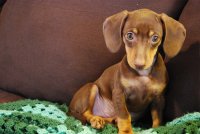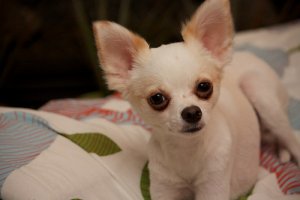Miniature Pinscher
1.- Miniature Pinschers are often called the “King of the Toys”. It has been noted by researchers that an Egyptian God, “Anubis”, who’s images suggest it was a Miniature Pinscher guarded the temple of the Kings and pharaohs. Many paintings of the 1800’s included dogs who greatly resembled the Min Pins of today, so it is assumed their history does indeed span the centuries.
Mimsy
2.- Setting aside the speculation about the breeds early history, it is believed the Min Pin evolved from the ancient German Pinscher and is a cross of the Dachshund, where they inherited their energy and prey instincts, and the Italian Greyhound, where they inherited their courage, playful, feistiness and the cute little high-stepping “hackney” gait. .
3.-This lively, brave and intelligent dog is good around other pets and children, as long as you provide them with proper leadership and training. They are quick to understand and obey but are also known to have a mind of their own.
4.-How a miniature pinscher behaves is solely dependent on how you treat him. Prevent them from falling into the Small Dog “Napoleon” Syndrome where they believe they are pack leader to humans as this will lead to their becoming headstrong and demanding.
Zeek
5.-Min Pins are good and eager learners who will benefit from puppy and agility courses that enable them to socialize and burn off the excess energy. They are incredibly social and get along well with other dogs and people. Min Pin’s do not enjoy being left alone due to being pack animals and are best in a household where someone is home with them for periods through out the day.
6.- The Miniature Pinscher was commonly used as a barnyard ratter to control rodents in stables, barns in the 1800’s. They have since become a great pet for any type of environment as long as their safety and protective measures are maintained in the home. Min Pins have a very curious quick mind that will get them in a lot of trouble if left to their own accord chasing anything that moves.
7.- A lifestyle with daily exercise and high levels of obedience skills with kind and consistent training will allow you years of enjoyment for everyone.
Lola
8.- Miniature Pinschers life expectancy is an average fifteen years, but with a healthy diet, lots of exercise, and health care they can live years longer.
9.- Min Pins have smooth, short-haired coats that are easy to groom. All you need is a soft bristle brush and occasionally some shampoo to get their coat looking perfect. Use a warm damp cloth to wipe the coat and get rid of loose hair. This dog breed is an average shedder.
10.- They are generally healthy and great for dog owners living in apartments. They tend to be very active indoors and will do just fine without a yard to play in. Min Pins need exercise every day in order to fulfill their primal instinct otherwise they can become destructive and search for ways to take out their energy
Good to Know:
Min Pins are excellent escape artists, and should not be allowed out of doors unsupervised, even in a securely fenced area, and absolutely NEVER allowed off leash.
They like to chew on small objects which could easily lead to choking.
They love to burrow under covers and cuddle with their people.
They must be protected from the cold due to their short hair. Blankets, coats and such are important … But, hey, they look great in a sweater!
Zeek, Marley and Mia
If you want a Min Pin, always check your local shelters first, or go to a Min Pin rescue site for information:
Dachshunds
1.- Dachshunds are commonly known as “wiener dogs” because of their long and low bodies, but the name actually means “badger dog” in German.
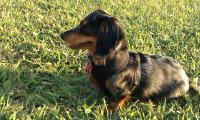
Gracie May-long-haired, double-dapple
2.- They were bred to hunt badgers and rabbits. Their short legs allow them to get into burrows and dig after their pray. So it’s their instinct to dig and burrow, so don’t be surprised to find him buried under your blankets.
3.- As with other short dogs, the Dachshund needs to exercise to avoid gaining weight, which will cause serious back problems. They do have a tendency to be lazy and eating too much.
4.- They come in many different sizes: standard and miniature. Varying coat lengths: short haired, long haired and wired haired. Colors: there are solid colors, 2 or 3 colors, brindles, dapples, double and triple dapples and piebalds. You have a lot to choose from!
5.- You’ll love the Dachshund personality! They are curious, clever affectionate, brave, and very, very amusing! They are very playful and will chase anything small, including little kids. Want to drive them crazy? Get a laser light.
6.-You need to train them and let them know who’s the leader of the pack, otherwise they will tell take over your home and can start having behavior problems like biting, obsessive barking and over-protectiveness of toys, food and people.
7.- Dachshunds have all the traits of a small dog, including that they are not very suitable for young children unless they are gentle
and respectful. They should not (easy to say) be treated like babies, because, again, they will become the boss.
8.- They are very active dogs with tons of stamina, so you need to walk them every single day, and have frequent sessions of outdoor play. Don’t encourage them to jump, because Dachshunds can really hurt their back.
9.-They can be incredibly mischievous at times. You have to keep them on a leash at all times, because if they catch an interesting smell, they will take off running after whatever it is.
10.-They really bond to one person in the family, although they are happy in a family environment. But the “chosen one” will never go to the bathroom alone ever again.
Important to know
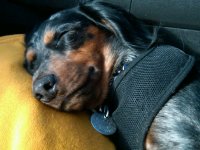
Gracie May
They are very independent and quite stubborn, therefore hard to train, but it is doable
They love being with other Dachshunds.
They love belly rubs.
They just love to bark!!!
Photos courtesy of: asillymuse, Amy Klein and Gracie May
Pembroke Welsh Corgis
1.- The Pembroke Welsh Corgi has a long body and stubby legs, which make him a very interesting and cute breed.
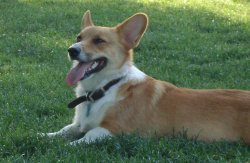
Yoda, relaxing at the park
2.- The Corgi is the smallest of the herding dogs. They nip at the heels of cows and then roll out of the way to avoid the kick.
3.- There are two breeds of Corgis: the Pembrokeshire, Wales, and the Cardigan Welsh. The Pembroke is born without a tail. The Cardigan has a long tail.
4.- Pembrokes like to eat! They can gain weight easily if you feed them too much, and they need exercise. If they get fat, they can have serious back problems.
5.- Some interesting Pembroke Welsh Corgi information: They come in five colors: red , sable , fawn , red-headed tricolor and black-headed tricolor
6.- It is said that the Vikings brought the dogs with them as they traveled to reside in Wales.
7.- They are awesome performers in agility trials.
8.- They are very friendly dogs and are great at training. They need to be trained well so that they won’t try to herd your family!
9.- Although they would rather live on a farm, they can adapt to different living situations, as long as they are provided with regular exercise.
10.- The coat is low maintenance, but it does need to be brushed often to avoid shedding.
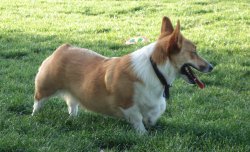
Yoda (my favorite Corgi)
Important to know
They are very friendly and even shy sometimes, but they need to be socialized to avoid herding behavior, particularly with small children. If they are not properly trained, they might try to nip their ankles.
They need exercise and distraction, that’s why they are so great at agility trials. Otherwise they can become bored, fat and destructive.
Warning: you can get totally addicted to these dogs!
Every state has a Corgi Rescue. Consider rescuing before looking for a breeder.
Weimaraners
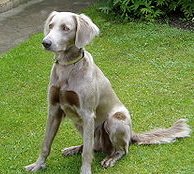
Long Haired Weimaraner
1.- They have a very smooth short coat that comes in all shades of gray.
2.- There is also a rare long haired variety that has a gorgeous silky coat, with an undocked, feathered tail.
3.- Females can weigh between 55 to 70 lbs, and males can weigh between 70 to 80 pounds.
4.- If you have a Weimaraner, you better have a big back yard and be quite athletic, since these dogs need tons of exercise. If they don’t exercise and play they can become very destructive.
5.- The Weimaraner temperament is cheerful and affectionate, but they do need to be well socialized from puppyhood. They are very protective of their family and very territorial.
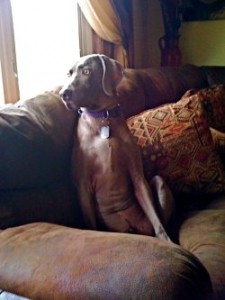 6.- They are good with children, but they need to be controled because they have a tendency to knock kids over with their rambouciousness. They can also be too rough for elderly people.
6.- They are good with children, but they need to be controled because they have a tendency to knock kids over with their rambouciousness. They can also be too rough for elderly people.
7.- The Weimaraner are also known as the “Velcro Dogs”. They get totally attached to their owners and won’t separate from them.
8.- They can suffer from severe separation anxiety, and cannot be left alone too long. This is not a dog to keep in the back yard. They have to be members of the family.
9.- They suffer from gastric problems. They are prone to bloat or suffer from gastric torsion, which is a serious condition that needs to be treated right away.
10.- They need to be trained well to become the wonderful gentle and protective companions that they can be.
Important to know
Did you know that Weimaraners were bred for hunting Lions?
Most Weimaraner owners say their dogs own them and not the other way around.
Pomeranians
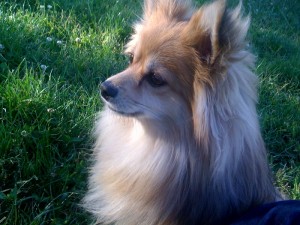 1.- Pomeranians can come in a variety of sizes. They can range from 2 to 30 pounds. The tiny sized dogs are the most popular, but since they are descendants of the German Spitz, sometimes they jump back to their ancestry even when coming from small sized parents.
1.- Pomeranians can come in a variety of sizes. They can range from 2 to 30 pounds. The tiny sized dogs are the most popular, but since they are descendants of the German Spitz, sometimes they jump back to their ancestry even when coming from small sized parents.
2.- They respond great to training, since they are super intelligent dogs that love to please their owners.
3.- They tend to bark a lot in response to any outside noise, so it’s important to let them know that barking once or twice when the doorbell rings is okay, but then they should stop.
4.- It’s very easy to spoil them since they are so cute and wonderful, but you should teach them to be independent so they don’t start suffering from separation anxiety or become clingy.
5.- They are surprisingly low maintenance despite their beautiful coats. They do need brushing, but their fur doesn’t normally tangle or get matted.
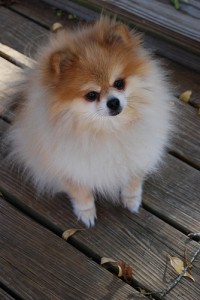 6.- You have probably seen Pomeranians with funky haircuts, like Mohawks or the famous “Bear Cut”, however, keep in mind that once you cut or shave your Pom’s fur, it will never grow back as soft and beautiful. So make sure that’ s the look before you want for your dog before you take it to the groomer.
6.- You have probably seen Pomeranians with funky haircuts, like Mohawks or the famous “Bear Cut”, however, keep in mind that once you cut or shave your Pom’s fur, it will never grow back as soft and beautiful. So make sure that’ s the look before you want for your dog before you take it to the groomer.
7.- Some Poms don’t have as much undercoat as others, that’s why not all of them are as fluffy.
8.- You can find them with the little round face called “the bear face” or with a more elongates snout called “the fox face”. The fox face is the original, the bear face was developed for show as the breed shrunk.
9.- They come in so many different colors! White, black, brown, red, orange, cream, blue, sable, tan, merle, spotted, brindle, and every combination of these colors.
10.- They bond with their owners very quickly, however, as is the case with other small dogs, they are not the best for very small children.
Important to know
One good thing to know about Poms, is that they always go through their “puppy uglies” phase. All of a sudden the gorgeous coat disappears and they look like ugly ducklings. Relax, this passes at about 9 months, and they the fur grows out in it’s full splendour.
Photo of tiny Pomeranian courtesy of: Bluelight444
Chihuahuas
1.- There are two kinds of Chihuahuas: Apple head, with a short nose and round head, and Deer head, with a more elongated face.
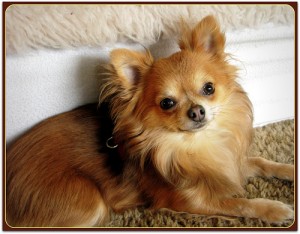 2.- They come long haired or short haired. The short haired has a smooth coat and sheds minimally. The long haired Chihuahua’s coat is silky, curly or flat.
2.- They come long haired or short haired. The short haired has a smooth coat and sheds minimally. The long haired Chihuahua’s coat is silky, curly or flat.
3.- They come in many colors: sand, black, fawn, white, black and white… and more.
4.- They are the tiniest dog breed.
5.- They do better with solid, dry food. Soft and canned food can promote dental problems.
6.- They are highly intelligent and can be hard to train. They require firm and gentle leadership.
7.- They gain weight easily, which can be very harmful to their health.
8.- They look very active at home, but that should not take the place of a good walk. When they are not walked often, they can present behavior problems.
9.- They can live from 14 to 19 years.
10.- They like to form ‘”clans” and will get along better with other Chihuahuas than other breeds.
They need to be very well socialized. If you allow them to be the pack leader, they’ll become possessive and even aggressive towards strangers. They can also be aggressive towards other dogs.
Though they are cute and tiny, they are not recommended for children.
Their temperament depends totally on how the owners treat them. If the owners are overly protective and baby them too much (which is the tendency) they will not be trustworthy pets. They can even become obnoxious.
Shelters tend to have large amounts of Chihuahuas. People tend to abandon them when they realize they are not the “toys” they hoped they would be. They represent a big responsibility.
Yes, their name comes from the Mexican State of Chihuahua, where they were discovered, but they date as far back as the 9th century AD and were found in the Aztec capital.
Long Haired Chihuahua Photo Courtesy of: Phoenix wolf-ray
Apple Head Chihuahua courtesy of: blackdood
Brittany Spaniels
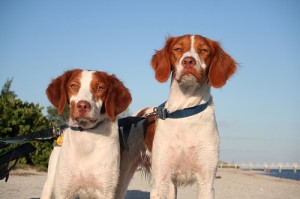 1.- Their long legs have the same length as their body.
1.- Their long legs have the same length as their body.
2.- The ones with black noses cannot compete in dog shows.
3.- It’s a very gentle, happy breed, great as a companion pet.
4.- They really need a pack leader. Their owner needs to be firm, but calm and confident.
5.- They are good for kids when they are raised with them from puppyhood .
6.- They don’t do very well in apartments. They are very active.
7.- They are very healthy dogs, although some are prone to hip dysplasia.
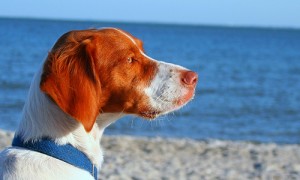 8.- They have so much energy, they could be destructive if left alone.
8.- They have so much energy, they could be destructive if left alone.
9.- They like calm environments. They can get very stressed around loud voices and noise.
10.- They are very trainable and require lots of mental stimulation.
Important to know
They are prone to pee when they are exited or nervous.
They need to be very well socialized from puppyhood for them not to become fearful and shy.
If you are not willing to go running, hiking, swimming and have a very active lifestyle, this breed is not for you.
And no… despite their name, they have nothing to do with Great Britain. They come from the French province of Brittany.
Irish Wolfhound
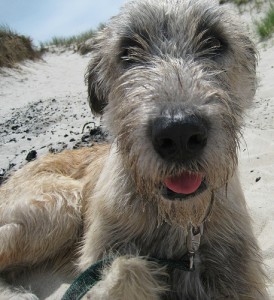 1.- They are huge. They are considered the tallest dogs, although once in a while a Great Dane will grow taller.
1.- They are huge. They are considered the tallest dogs, although once in a while a Great Dane will grow taller.
2.- They are very muscular and can reach the size of a small pony.
3.- They are hunting dogs, and two of their characteristics are speed and endurance.
4.- They are quiet and peaceful and make a very good family pet.
5.- They don’t have a soft coat. It’s wiry and rough.
6.- They can adapt to city living as long as they are exercised enough.
7.- They were feared in ancient Rome, where they would only be transported in cages.
8.- They are the oldest known breed of dogs.
9.- In the 19th Century, they were so costly that only royalty could own them.
10.- They will protect their family, but they don’t make very good guard dogs.
Important to know:
T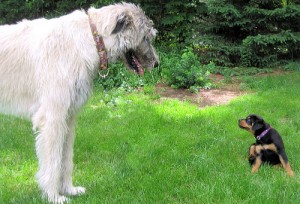 hey should not be given supplements, a good food will suffice. This helps to slow down their rapid growth.
hey should not be given supplements, a good food will suffice. This helps to slow down their rapid growth.
They should not be exercised strenuously until they are 18 months old to avoid irreparable damage to their limbs.
They don’t live very long lives. Between 5 and 10 years. They are genetically predisposed to many ailments.
And yes… they were bred to hunt wolves.


